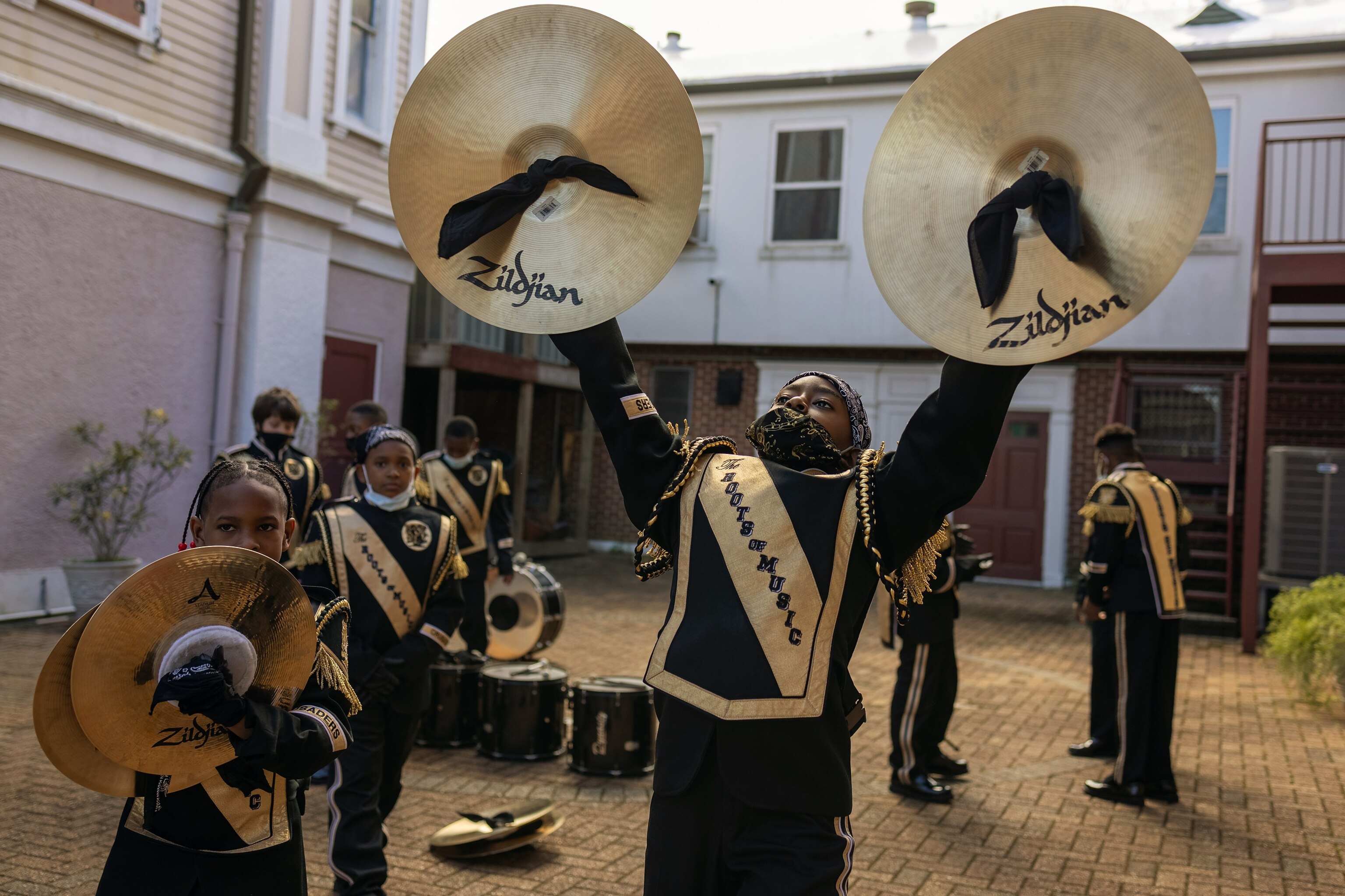
New Orleans youth marching band dancing in the streets after COVID hiatus
“It’s like a warm feeling across my body.” Music fills streets and souls with return of Mardi Gras.
New Orleans — A year ago, 13-year-old Courtney Jones regularly got into fights on the school bus. His grades usually hovered around a D average. Sometimes, children he knew in his neighborhood might talk with him about how fun it was to break into cars. He never did it. But that’s the kind of influences he was around.
Then he joined The Roots of Music Crusaders Marching Band, an ambitious afterschool program provided free-of-charge to 102 New Orleans middle school children between the ages of nine and 14. It was founded in 2008 by snare drummer Derrick Tabb, an alum of the Grammy Award-winning Rebirth Brass Band. Tabb insisted that the program provide buses to get the children to the program, as well as tutors and meals once they’re there.
“It’s my ‘no-excuses’ plan,” says Tabb, whose six-foot-four frame can be seen from blocks away as he marches with the children through the surrounding neighborhood. Every night, he and his staff have been preparing the young musicians to perform in three-hour-long parades as New Orleans hosts its first Mardi Gras celebration in two years following a temporary halt due to the COVID-19 pandemic.



Though the majority of the band members are boys, girls also participate. They include 10-year-old clarinetist Skylar Carter, who attends St. Leo the Great Catholic School. She reports two benefits beyond the joy of performing with Roots: “My grades have improved,” she says. “Plus, I get to skip Catechism.”
As the first parades approached, nerves hit eight-year-old Dedric Powell, who belongs to the “Sprouts of Music” spinoff of Roots for younger kids. “I feel special because I’m in the front,” says Dedric, one of two children who carry swords and march directly behind the band’s banner. “But I’m still scared because we’re marching for the first time. And I’m supposed to keep my eyes looking forward. But if the floats are throwing beads ahead of us, I’m worried that I might slip on those beads.”



Outside, in the school’s brick courtyard, Courtney and two of his friends, 14-year-old Tyler Guidry and 13-year-old Chad Brown, both baritone players, were doing 100 push-ups while Tabb stood nearby and watched. The push-ups were penalty for the boys’ typical misbehavior: laughing and joking.
While the trio still needs to be disciplined every now and then, the frequency of those push-ups has declined in recent months. Courtney’s grades also have improved significantly, first to Cs, and now to Bs, and even some As. His school has started to call the staff at Roots whenever he misbehaves—as he did recently when he yelled at a girl and was sent home with a laptop for two weeks of virtual learning.



Still, Courtney is proud of the enormous growth he’s experienced since he first picked up his horn 11 months ago. “It’s like a warm feeling across my body,” he says.
He practices his mellophone at home at night—to the joy of his neighbors, who tell him how good he sounds. His younger sister Ka’ny, whom he calls “Pie,” is learning to be a majorette and often twirls her batons while Courtney plays. Sometimes the two of them march, twirling and playing songs, around their Irish Channel neighborhood, where they live with their grandmother, Cathy Jones.
Jones knows what drives Courtney to be disruptive at school. Though she is his guardian, he still sees his parents, both of whom suffer from mental health conditions. That bothers him, his grandmother says. “He is dealing with some things inside him.”
Courtney acknowledges that he feels bad if a parent shows up and causes a stir. But he says being in the Roots of Music program helps him focus on something positive. “Now, when I’m in school, I think to myself, I just need to get through this whole day, because I know after school, when I have practice, I can play my horn and do what I want to do. My life now is school, practice, sleep, repeat.”
Though many programs focus on younger children or on teenagers, the middle schoolers that Roots targets are at a crucial age, says Emily Wolff, director of the Mayor’s Office of Youth and Families. “They are going through physical and emotional changes and really developing a sense of identity, about what they’re interested in and who they want to be around.”
Because of the pandemic and an increase in gun violence in the city, many local children end up isolated at home, Wolff says. That isolation takes a mental toll, unless they can spend time after school in a safe, family atmosphere like Roots.

Tabb says that this year’s band is “unlike any other.” While Courtney started learning to play his horn 11 months ago, 90 percent of his band are beginners who first picked up their instruments just three months ago. But there’s a zeal Tabb hasn’t seen before, with children begging to stay late at the program. Daily attendance rates are up to 95 percent, higher than ever before. “They’re putting their all into it,” Tabb says, “because they know what life is like without it.”













